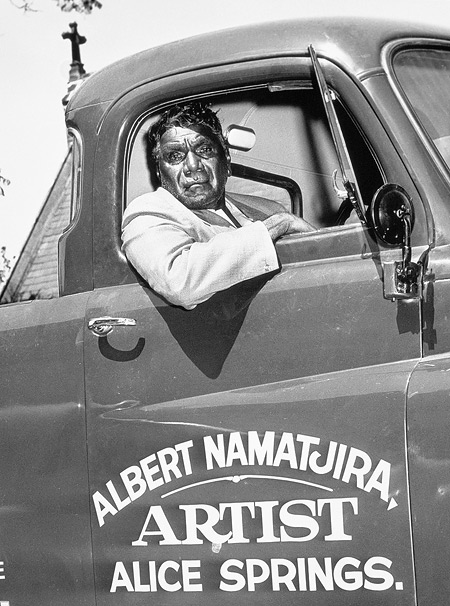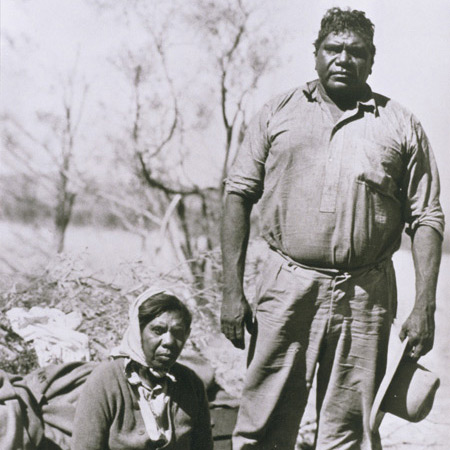Albert Namatjira
It was customary for the Lutheran Mission at this time to baptise Aboriginal people with only one name.
Albert Namatjira was born on 28 July 1902, the first son of Namatjira and Ljukuta. His father was baptised at the Hermannsburg Lutheran Mission in 1905 and adopted the name ‘Jonathan’, and his mother was blessed with the name ‘Emilie’. In the same ceremony, their son Elea, was also baptised and given the now famous name, ‘Albert’.
The Hermannsburg Lutheran Mission was located at the base of Mt. Hermannsburg on the banks of the Finke River in central Australia. Established by missionaries Pastor Kemp and Schwarz in 1877, the settlement was named after the German town, Hermannsburg, where they had trained. Namatjira attended the Lutheran Mission school as a young boy and at thirteen underwent his traditional initiation.
Around eighteen years of age, Namatjira left Hermannsburg to elope with Ilkalita. The couple returned to the mission with their three children in 1923 where Ilkalita was baptised and adopted the name ‘Rubina’.
To support his family, Namatjira worked on neighbouring cattle stations and made mulga wood plaques decorated with hot poker designs. He was a competent craftsman, however, following a meeting with Melbourne artist Rex Battarbee during an exhibition of his work at the mission, Namatjira seriously turned his mind to the idea of painting for a living.
Eager to see what he could produce himself, Namatjira requested artist materials from the mission’s superintendent, Pastor Friedrich Albrecht, who then contacted Battarbee for assistance. In reply, Battarbee sent Namatjira his first box of watercolours and the paper to begin experimenting.
Battarbee returned to Hermannsburg in 1936 and offered Albert painting lessons in return for his guiding and camaleering skills. The men set off on a two month journey into the MacDonnell Ranges, where Namatjira shared stories of his country while learning the basic techniques of watercolour painting. Battarbee was impressed by Namatjira’s ‘remarkable aptitude in draftsmanship and colour’ and would later select three of his early paintings for an exhibition in Adelaide.
Prior to this exhibition all of Namatjira’s watercolours were signed 'ALBERT'. Before the opening of his exhibition in Melbourne he was advised to adopt a second name and chose his father's tribal name, Namatjira.
While Namatjira earned some money from the paintings he sold in city galleries, it was not until the opening of his first solo show in 1938 at the Fine Art Society Gallery in Melbourne that he truly saw the potential of earning a decent income. By combining his deep knowledge of the landscape with the watercolour skills learned from Battarbee, Namatjira had developed an entirely unique form of painting that captivated audiences around the country.
Namatjira continued to develop his painting and, in 1945, held his first solo exhibition in Sydney. The show was another great success and the income generated by these sales allowed him to build a small cottage for his family just a few kilometres from the Hermannsburg Mission.
The following year, Namatjira was the subject of a biographical documentary, Namatjira the Painter, produced by C.P. Mountford for the National Film Board. The cameraman, Axel Poignant, spent three months shooting the film at Hermannsburg, taking hundreds of black and white photographs of the artist and his community.
Namatjira continued to exhibit his work successfully over the next ten years. In 1953, he was awarded the Queen’s Coronation Medal and the following year travelled to Canberra to meet the young Queen Elizabeth II. Although surrounded by the pomp and ceremony of government, it is remarkable that he would still have another three years to wait before he was granted Australian citizenship status.
One of the consequences of Namatjira’s citizenship was that he was legally entitled to buy alcohol. However, when he shared it with his fellow Arrernte artist, Henoch Raberaba, he was charged with supplying liquour and sentenced to six months imprisonment. There was a public outcry over the decision and, after two appeals; his sentence was reduced to three months.
It was not until the 1967 Referendum on Aboriginal citizenship that the same rights were granted to all Indigenous Australians.
Albert Namatjira died the following year on the 8 August 1959. More than fifty years after his death, he remains the most celebrated Aboriginal painter in Australian history.



